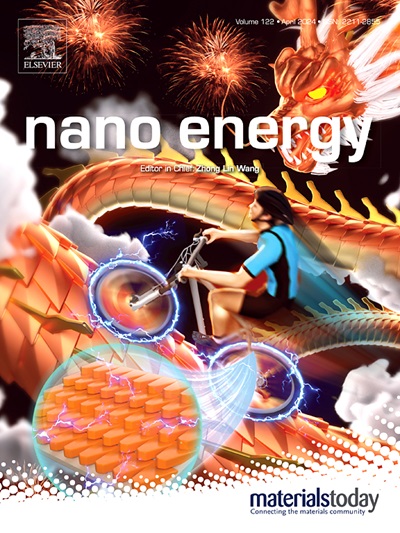实现高效稳定的包晶最小模块的埋入式界面调节
IF 16.8
1区 材料科学
Q1 CHEMISTRY, PHYSICAL
引用次数: 0
摘要
由于过氧化物太阳能电池(PSCs)中的埋入式界面对设备性能和稳定性的影响,目前是一个备受关注的研究领域。然而,如何合理设计埋入式界面仍然是一项重大挑战。埋藏界面的特性不仅会影响载流子的重组和包晶层的传输,还会影响它们的结晶度、取向和缺陷。在这项研究中,配体修饰的 ZrO2 纳米粒子(NPs)被引入作为 PSCs 掩埋界面的功能桥接层。这种致密的超薄绝缘层可以有效地阻挡空穴,但允许电子通过 "隧道 "效应,从而减少 ETL 和过氧化物体之间的电荷重组。此外,NH2 基团官能化的 ZrO2 NPs 还能重新配置基底,实现包晶薄膜的定向生长,并最大限度地减少底部缺陷。这种在埋藏界面上对载流子行为和薄膜物理性质的双重调制对于提高器件性能和扩展性都非常有效。冠军小面积 PSC(有效面积为 0.0655 平方厘米)的效率可达 26.51%。此外,PSC 微型模块在 23.23 平方厘米(认证为 22.32%)和 87.45 平方厘米(认证为 22.26%)时的效率也分别达到了 23.42%和 22.26%。根据 ISOS 稳定性协议的先进水平,这些装置还显示出卓越的货架寿命/光浸泡稳定性。本文章由计算机程序翻译,如有差异,请以英文原文为准。

Buried interface regulation for efficient and stable perovskite minimodules
Buried interface in perovskite solar cells (PSCs) is currently a highly focused study area due to their impact on device performance and stability. However, it remains a major challenge to rationally design buried interfaces. The properties of the buried interface not only affect carrier recombination and transport of perovskite layers, but also their crystallinity, orientation, and defects. In this work, ligand-modified ZrO2 nanoparticles (NPs) were introduced as a functional bridging layer at the buried interface of the PSCs. The dense, ultra-thin insulating layer can effectively block holes but allow electrons to pass through the "tunneling" effect, thereby reducing charge recombination between the ETL and the perovskite bulk. In addition, ZrO2 NPs functionalized with NH2 groups can reconfigure the substrate to realize oriented growth of perovskite film and minimize bottom defects. This dual modulation of carrier behavior and film physical properties at the buried interface is very effective for improving both device performance and scaling. The efficiency of the champion small-area PSCs (with an active area of 0.0655 cm2) could reach 26.51 %. Moreover, the efficiencies of the PSC minimodules could reach 23.42 % at 23.23 cm2 (certified as 22.32 %) and 22.26 % at 87.45 cm2, respectively. These devices also showed excellent shelf-life/light soaking stability based on the advanced level of ISOS stability protocols.
求助全文
通过发布文献求助,成功后即可免费获取论文全文。
去求助
来源期刊

Nano Energy
CHEMISTRY, PHYSICAL-NANOSCIENCE & NANOTECHNOLOGY
CiteScore
30.30
自引率
7.40%
发文量
1207
审稿时长
23 days
期刊介绍:
Nano Energy is a multidisciplinary, rapid-publication forum of original peer-reviewed contributions on the science and engineering of nanomaterials and nanodevices used in all forms of energy harvesting, conversion, storage, utilization and policy. Through its mixture of articles, reviews, communications, research news, and information on key developments, Nano Energy provides a comprehensive coverage of this exciting and dynamic field which joins nanoscience and nanotechnology with energy science. The journal is relevant to all those who are interested in nanomaterials solutions to the energy problem.
Nano Energy publishes original experimental and theoretical research on all aspects of energy-related research which utilizes nanomaterials and nanotechnology. Manuscripts of four types are considered: review articles which inform readers of the latest research and advances in energy science; rapid communications which feature exciting research breakthroughs in the field; full-length articles which report comprehensive research developments; and news and opinions which comment on topical issues or express views on the developments in related fields.
 求助内容:
求助内容: 应助结果提醒方式:
应助结果提醒方式:


